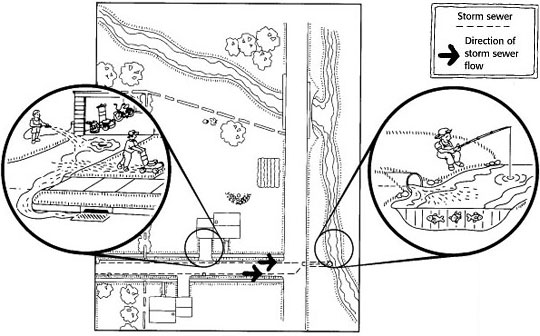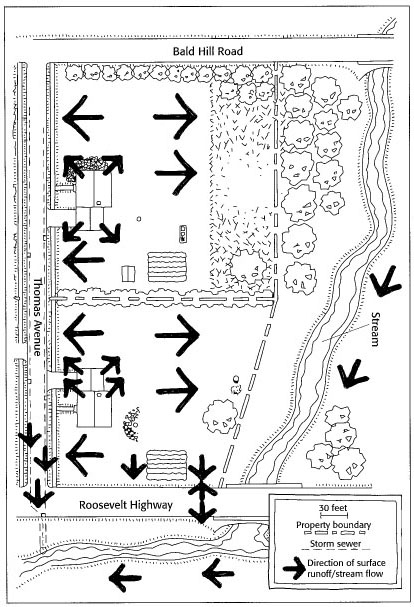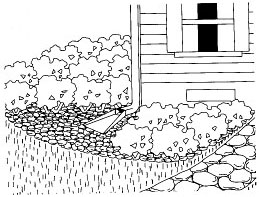Fact sheet 2
This fact sheet examines potential risks to the environment and your health from storm water runoff. Two areas are covered:
- Part 1
Reducing pollutants in runoff
Pollutants can include pesticides and chemicals, automotive wastes, grass clippings and yard waste, pet and animal manure, and winter salt and de-icers. - Part 2
Landscaping and site management to control runoff
Some ways to help control runoff are preventing soil erosion, providing basement flood protection, landscaping, providing proper roof drainage, and minimizing paved surfaces.
Completing this fact sheet will help you evaluate how storm water affects the environmental quality of your property and properties downstream. You will also learn ways to reduce pollution risks.

Figure 2.1
Runoff that flows into storm sewers goes directly to streams and lakes without treatment.
What is storm water?
Storm water is water from rain or melting snow that does not soak into the ground. It flows from rooftops, over paved areas and bare soil, and through sloped lawns. As it flows, this runoff collects and transports soil, pet manure, salt, pesticides, fertilizer, oil and grease, leaves, litter and other potential pollutants.
You don't need a heavy rainstorm to send pollutants rushing toward streams, wetlands, lakes and oceans. A garden hose alone can supply enough water.
Even if your house is not on a waterfront, storm drains and sewers efficiently convey runoff from your neighborhood to the nearest body of water. Contrary to popular belief, most storm sewers do not carry storm water to wastewater treatment plants (Figure 2.1). Storm and sanitary sewers may be combined in some older communities.
Why should you be concerned?
Polluted storm water degrades our lakes, wetlands and rivers. Soil clouds water and degrades habitat for fish and water plants. Nutrients such as phosphorus and nitrogen promote the growth of algae, which crowds out other aquatic life. Toxic chemicals, such as antifreeze and oil from leaking cars, carelessly applied pesticides, and zinc from galvanized metal gutters and downspouts, threaten the health of fish and other aquatic life. Bacteria and parasites from pet manure can make nearby lakes and bays unsafe for wading and swimming after storms.
As many people have discovered, storm water can be a problem closer to home. It can flow into basements and cause damage that is difficult and costly to clean up. Storm water can also flow down a poorly sealed well shaft and contaminate drinking water. In areas with very porous soils or geology, pollutants in runoff may reach groundwater.
Public officials are focusing pollution control efforts on storm water management in urban and rural areas. Storm water pollution cannot be treated in the same way as water pollution from discharge pipes, because it comes from many sources (Table below).
It is carried by storm water from every street, parking lot, sidewalk, driveway, yard and garden. The problem can only be solved with everyone's help.
Common sources of storm water pollutants
| Pollutant | Common sources |
|---|---|
| Silt, sand, and clay particles and other debris. | Construction sites; bare spots in lawns and gardens; wastewater from washing cars and trucks on driveways or parking lots; unprotected stream banks. |
| Nutrients | Over-used or spilled fertilizers; pet manure; grass clippings and leaves left on streets and sidewalks; leaves burned in ditches. |
| Disease organisms | Pet manure and garbage. |
| Hydrocarbons | Car and truck exhaust; leaks and spills of oil and gas; burning leaves and garbage. |
| Pesticides | Pesticides over-applied or applied before a rain-storm; spills and leaks. |
| Metals | Cars and trucks (brakes and tire wear, exhaust); galvanized metal gutters and downspouts. |
Part 1
Storm water
Reducing pollutants in runoff
Storm water is unavoidable, but its effects can be reduced by keeping harmful chemicals and materials out of runoff. This section reviews potential sources of contamination and offers ways to minimize them.
When you finish reading this section, fill out the work sheet to help identify storm water risks on your property.
 Figure 2.2
Figure 2.2
Map showing direction of surface runoff and stream flow.
Where does storm water go?
The next time you are home during a rain shower, head outdoors with your boots and umbrella and watch where the rainwater goes.
On a sketch of your property, draw arrows showing the direction that storm water flows off driveways, rooftops, sidewalks, and yards. A sample map is provided in Figure 2.2. (Instructions for making a homesite sketch can be found in Fact Sheet 1.) Does water soak into the ground quickly, or does it puddle in places and flow off lawns and driveways? Your soil type affects water infiltration (soaking into the ground). As you might expect, water infiltrates sandy soil quickly but has a hard time seeping into fine-grained silt or clay soils.
During your walk, note how far it is to the nearest storm sewer, ditch, wetland, stream or body of open water. Note whether runoff flows onto your land from adjacent streets, lands or storm water systems. If you live at or near the bottom of a hill, you may have special problems. Be sure to go out during more than one rain shower to get a good understanding of runoff flow during small and large storms.
Are any car or truck wastes being carried away by storm water?
Oil stains on your driveway and outdoor spills of antifreeze, brake fluid, and other automotive fluids are easily carried away by a rainstorm. An oily sheen on runoff from your driveway is a sure sign that you need to be more careful.
Use pans, carpet scraps or matting to catch drips. Routine maintenance can prevent your car from leaking and help identify potential leaks. If you change your own oil, be careful to avoid spills and collect waste oil for recycling.
Oily car parts and fluid containers should be stored where rain and runoff cannot reach them. Never dump used oil, antifreeze, or gasoline down a storm drain, in a ditch, or on the ground. These wastes will end up in a nearby lake or stream, or they may pollute your drinking water.
Washing your car in the driveway creates runoff without the help of a rainstorm — your hose provides the water. The dirty, soapy runoff drains directly into storm sewers, picking up oil and other pollutants as it goes. Try washing your car on the lawn or, better yet, take it to a commercial car wash or spray booth that sends its dirty water to a wastewater treatment plant.
Are household products stored outside the reach of storm water?
Most households store lawn and garden products like weed killers, insect killers and fertilizers. If storm water or floodwater reaches these products, it can transport them into surface water and possibly your well.
Pool chemicals, salt for water softeners, and a wide variety of other chemical products can also cause trouble if they are washed away.
Keeping such products in waterproof containers and storing them up high and out of the potential path of runoff or floods is important. You can avoid storage problems by buying only what you need for a particular task and then using up the product.
Prevent freezing of liquid products. Most pesticides, and some fertilizers, are liquid and may be subject to freezing. This may burst containers or render the product unusable.
Do you use and handle chemicals safely?
Safe storage is only the first step in preventing contaminated runoff. When mixing chemicals, try to do it within a washtub so spills will be contained. If you spill chemicals, act quickly to contain and clean up the spill. This is particularly important on paved surfaces.
Using more pesticides or fertilizers than you need invites problems. Timing of applications is also important. Do not apply pesticides and chemicals if rain is expected within twenty-four hours.
Read all pesticide labels carefully for application instructions and restrictions.
See Fact Sheet 5, "Yard and Garden Care," for more information on the proper use and handling of yard and garden products.
Do you use road salt or other de-icing products?
Road salt and de-icers eventually wash off paved surfaces and end up in the soil or water. From your driveway or sidewalk, salt can readily flow to storm drains and into streams and lakes.
Salt in high concentrations is harmful to wildlife and plants. Use less to keep these chemicals out of natural systems. If you use too much, clean up the excess. Consider sand or regular kitty litter as less toxic alternatives. Chipping ice off pavements is an even better choice, although care must be taken not to damage the pavement surface.
How is animal manure kept from becoming a pollution problem?
Droppings from dogs and cats and from other commonly kept animals like exotic birds, rabbits, goats and chickens can be troublesome in two ways. First, manures contain nutrients that can promote the growth of algae if they enter streams and lakes. Second, animal droppings are a source of disease.
The risk of storm water contamination increases if pet manures are allowed to accumulate in animal pen areas or if they are left on sidewalks, streets or driveways where runoff can carry them to storm sewers.
Droppings that are not mixed with litter or other materials should be flushed down the toilet. Or, if local laws allow it, droppings may either be buried or wrapped and put in the garbage for disposal.
Are yard and garden wastes kept out of storm water?
If left on sidewalks, driveways, or roads, grass clippings and other yard wastes will wash away with the next storm (Fgure 2.1).
Although leaves and other plant debris accumulate naturally in streams and lakes, homeowners can contribute excess amounts of plant matter, especially in areas with many homes. This can lead to water that is unattractive or green with algae and unsuitable for recreation.
Burning yard waste is not an environmentally friendly alternative, and it's illegal in some areas. Hydrocarbons and nutrients released by burning leaves contribute to water pollution as well as air pollution.
Rain washes smoke particles out of the air, and runoff picks up dust and ashes left on pavement or in ditches.
Avoiding the problem is easy — sweep clippings back onto the grass, and compost leaves and garden wastes on your property to recycle nutrients.
Assessment 1
Reducing pollutants in runoff
Use Assessment 1 in the accompanying work sheet to rate your storm water pollution risks. For each question, indicate your risk level in the right-hand column. Some choices may not correspond exactly to your situation. Choose the response that best fits. Refer to the sections above if you need more information.
Part 2
Storm water
Landscaping and site management to control storm water runoff
Some storm water risks can be controlled by making changes to buildings, paved surfaces, the landscape and soil surfaces. This section reviews some easily addressed problems as well as major landscape alterations you might want to consider.
Are there areas of bare soil around your home?
Areas of bare soil often exist in vegetable and flower gardens, on newly seeded lawns, and around construction projects. Even on gentle slopes, water from rain and snow can remove large amounts of soil and carry it to wetlands, rivers and lakes.
Planting grass or other ground covers is the best way to stop erosion. Putting a straw or chip mulch over gardens or newly seeded areas will slow erosion. Straw bales, diversion ditches and commercially available silt fences around construction sites can help slow runoff and trap sediment on-site. If you are working with a contractor, insist that precautions are taken to control runoff and erosion during construction.
Can you eliminate paved surfaces or install alternatives?
Concrete and asphalt roads, driveways and walkways prevent rainwater from soaking into the ground. When you have the choice, consider alternative materials such as gravel or wood chips for walkways.
Avoid paving areas such as patios. Where you need a more solid surface, consider using a "porous pavement" made from interlocking cement blocks or rubber mats that allow spaces for rainwater to seep into the ground. If you must pour concrete, keep the paved area as short and narrow as possible.
Is your basement protected from storm water seepage or flooding?
Storm water in your basement can be a hazard in two ways: first, if water carries contaminants or disease organisms into your home, and second, if water picks up chemicals stored in your basement and carries them into the sewer or ground. Basement windows or doors are common storm water entry points and should be sealed against leaks.
It is best if window and door sills are at least a foot above ground level. If windows are at or below ground level, they can be protected with clear plastic covers available in building supply stores. Window wells that extend above ground level can help divert storm water. Your yard should be sloped away from the foundation to prevent water from pooling near the house and leaking into the basement.
Does roof water flow onto pavement or grass?
Your house roof, like pavement, sheds water. If downspouts from roof gutters empty onto grassy areas, the water will have a chance to soak into the ground. Aim downspouts away from foundations and paved surfaces (Figure 2.4). For roofs without gutters, plant grass, spread mulch, or use gravel under the drip line to prevent soil erosion and increase the ground's capacity to absorb water. Consider using cisterns or rain barrels to catch rainwater for watering lawns and gardens in dry weather.
 Figure 2.4
Figure 2.4
Roof drainage should be directed to the lawn or a flower bed and away from the foundation and paved surfaces.
Can you change your landscape's layout to reduce runoff?
An essential part of storm water management is keeping water from leaving your property, or at least slowing its flow as much as possible. Many home lawns are sloped to encourage water to run off onto neighboring property or streets. Instead, you could provide low areas landscaped with shrubs and flowers to encourage water to soak into the ground. If your yard is hilly, you can terrace slopes to slow the flow of runoff and make mowing and gardening easier.
If you have a large lot, consider "naturalizing" areas with prairie, woodland or wetland plants. If your property adjoins a lake or stream, one of the best ways to slow and filter runoff is to leave a buffer strip of thick vegetation along the waterfront (Figure 2.5).
Good sources for ideas are your local MU Extension center, Natural Resources Conservation Service, or Soil and Water Conservation District offices.

Figure 2.5
To help prevent erosion, leave an unmowed buffer strip of thick vegetation along stream banks and lakeshores.
Assessment 2
Landscaping and site management to control storm water runoff
For each question in assessment 2 on the work sheet, indicate your risk level in the right-hand column. Select the answer that best matches your situation. Refer to part 2 above if you need more information to complete the table.
For more information
Contact your local MU Extension center, the Missouri Department of Natural Resources Technical Assistance Program, or Natural Resource Conservation Service Urban Conservationist for information on landscaping, nonpoint source pollution, and storm water management techniques.
Resources and publications
- Bay Book: A Guide to Reducing Water Pollution at Home (1993). Available from the Chesapeake Regional Information Service (CRIS), a project of the Alliance for the Chesapeake Bay, 6600 York Road, Baltimore, MD 21212; 800-662-2747.
- The following publications relating to storm water runoff are available from the University of Wisconsin Extension Publications, Room 170, 630 West Mifflin Street, Madison, WI 53703-2636; (608) 262-3346. Up to five copies are free; call for price information if you want more than five copies.
- Storm Sewers: The Rivers Beneath Our Feet (GWQ004)
- Cleaning Up Storm Water Runoff (GWQ016)
- Beneficial Landscape Practices (GWQ008)
- Car Care for Cleaner Water (GWQ019)
- Lawn and Garden Fertilizers (GWQ002)
- Shoreline Plants and Landscaping (GWQ014)
- Lawn and Garden Pesticides (GWQ011)
- Lawn Watering (GWQ012)
- Pet Waste and Water Quality (GWQ006)
- Practical Tips for Home and Yard (GWQ007)
Pollution prevention at home helps ensure your safety
For more information about topics covered in the Missouri Home-A-Syst series, or for information about laws and regulations specific to your area, contact your nearest MU Extension center.